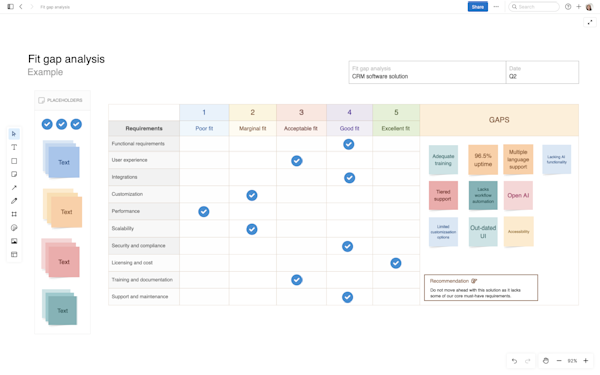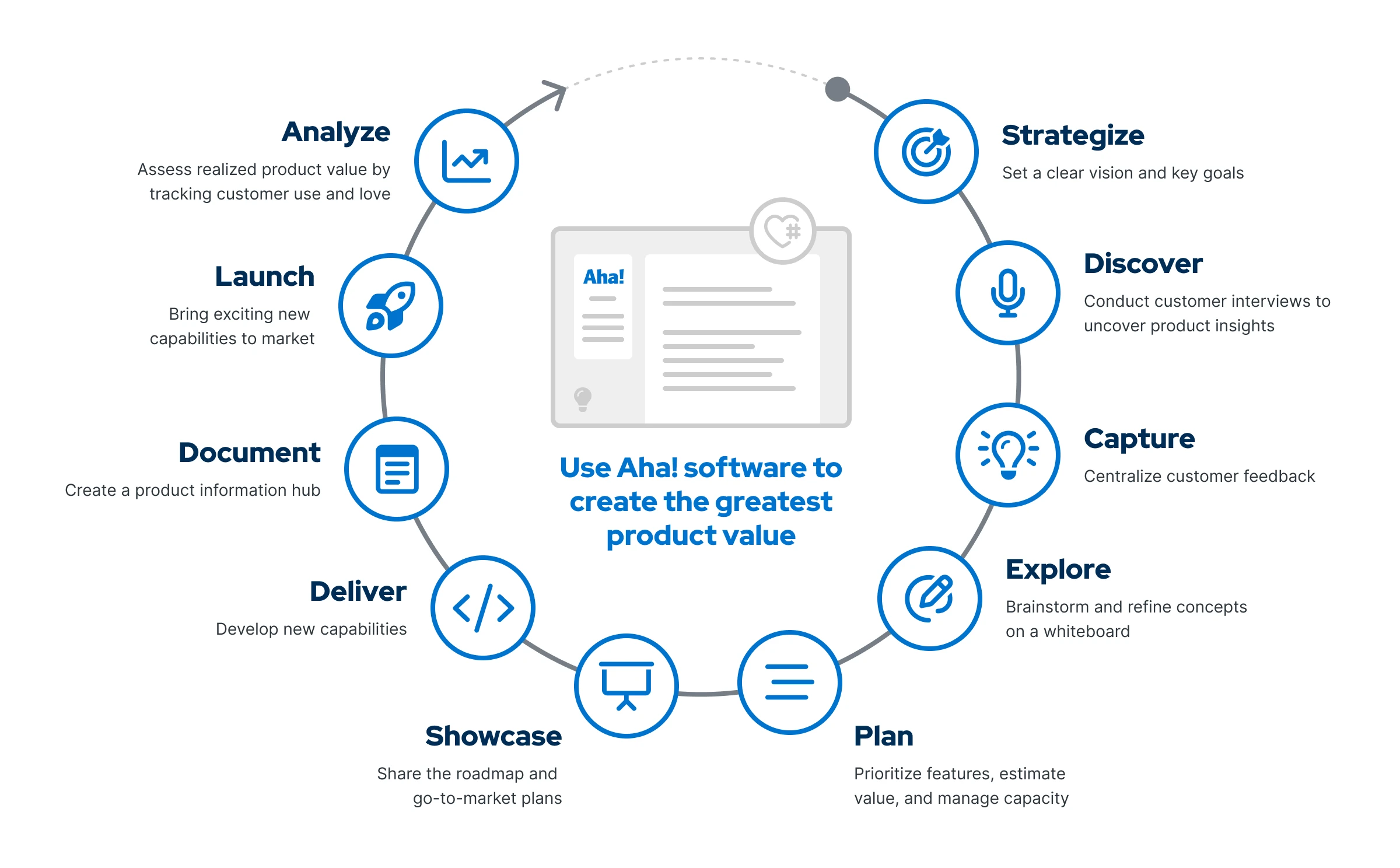
These are the stages of product development identified by Aha! experts. Our software suite covers every stage — so you can take a concept through to launch and beyond.
At each stage in the product development cycle pictured above, product management serves as the guiding hand. It centers leadership, engineering, and other cross-functional groups around a common vision and strategic direction for the work ahead. This requires a laser focus on business goals and a deep understanding of customers to make sure every decision leads to greater product value.
Related:
Where did product management get its start?
Product management is pretty well known today — particularly in the tech industry. But if you go back even just a few years, the function was less understood. (We spent a lot of time in the early days of Aha! writing what we call Versus posts comparing product management to other disciplines.) But even before product managers had a PM title, there were "product people" (brand managers, executives, and engineering leads) driving product growth and innovation:
Early 1900s: The concept of product management emerged as companies started producing goods at a larger, more ambitious scale thanks to technological advancements such as the assembly line. However, PM work was not formally introduced until 1931, when Procter & Gamble employee Neil H. McElroy drafted a memo to executive leadership. Although he was simply trying to justify hiring more people, his work impacted how we think about brand and product management.
1950s-1960s: During the post-World War II economic boom, businesses started focusing on marketing and selling their products to a more extensive consumer base. Product management evolved to include market research, product development, and strategic planning to meet customer demand.
1970s-1980s: The rise in technology and globalization motivated companies to adopt more structured product development approaches. This included introducing project management as a standalone function and closer collaboration with cross-functional teams such as engineering, sales, and marketing.
1990s and beyond: Then, the internet changed everything. It revolutionized product development, marketing, and sales. Product management expanded to include digital products and services, emphasizing user experience (UX) and continuous improvement.
Fast-forward to the present day, and product management now extends beyond product development and marketing to include the overall strategic direction of a company's portfolio. To thrive, products cannot be good (or even great). They must be lovable and fit into the bigger picture of what your company wants to achieve.
Related:
Why is product management important?
If you are reading this, we bet you already know how important product management is to a business. But to folks outside of the field, how do you describe its essential nature?
Here is a good way to articulate it: Product management enables teams to build products that meet real customer needs.
Product management drives business success in a few significant ways:
Ensures products are aligned with market needs, boosting sales and success
Grows revenue and profitability through strategic pricing and feature optimization
Strengthens the company's competitive position by continuously innovating and improving the offering
Enhances the customer experience and fosters product advocacy
Balances competing priorities, focusing on initiatives that will have the greatest impact on business goals
Companies achieve sustainable success based on the strength of their offering. And although product management does a lot of the heavy lifting, product building is a cross-functional endeavor. Product management acts as a bridge between engineering, design, marketing, sales, and customer support. People who work in product management facilitate communication among these teams, making sure everyone is working toward the same product goals.
From understanding customer needs and setting strategy to maximizing product value and market success, product management is the driving force behind it all.
Product management vs. project management
Product management and project management — two sides of the same coin? The short answer: It depends. The work that product managers and project managers do is usually quite distinct. But there is overlap, especially within small and midsize companies.
Here's how we would break down the two:
Product management is primarily concerned with defining the "why" and "what" of a product. PMs set the strategy, build the product roadmap, and prioritize what to build. It is an ongoing effort — you are managing the entire lifecycle of the product from launch through its subsequent releases, iterations, and so forth.
Project management focuses more on the "how," "when," and "who." Project managers oversee implementation or a series of activities within a certain time frame, helping the team deliver on time and on budget.
Product management and project management are complementary disciplines. The table below adds more detail around how both functions work together to ensure successful product delivery.
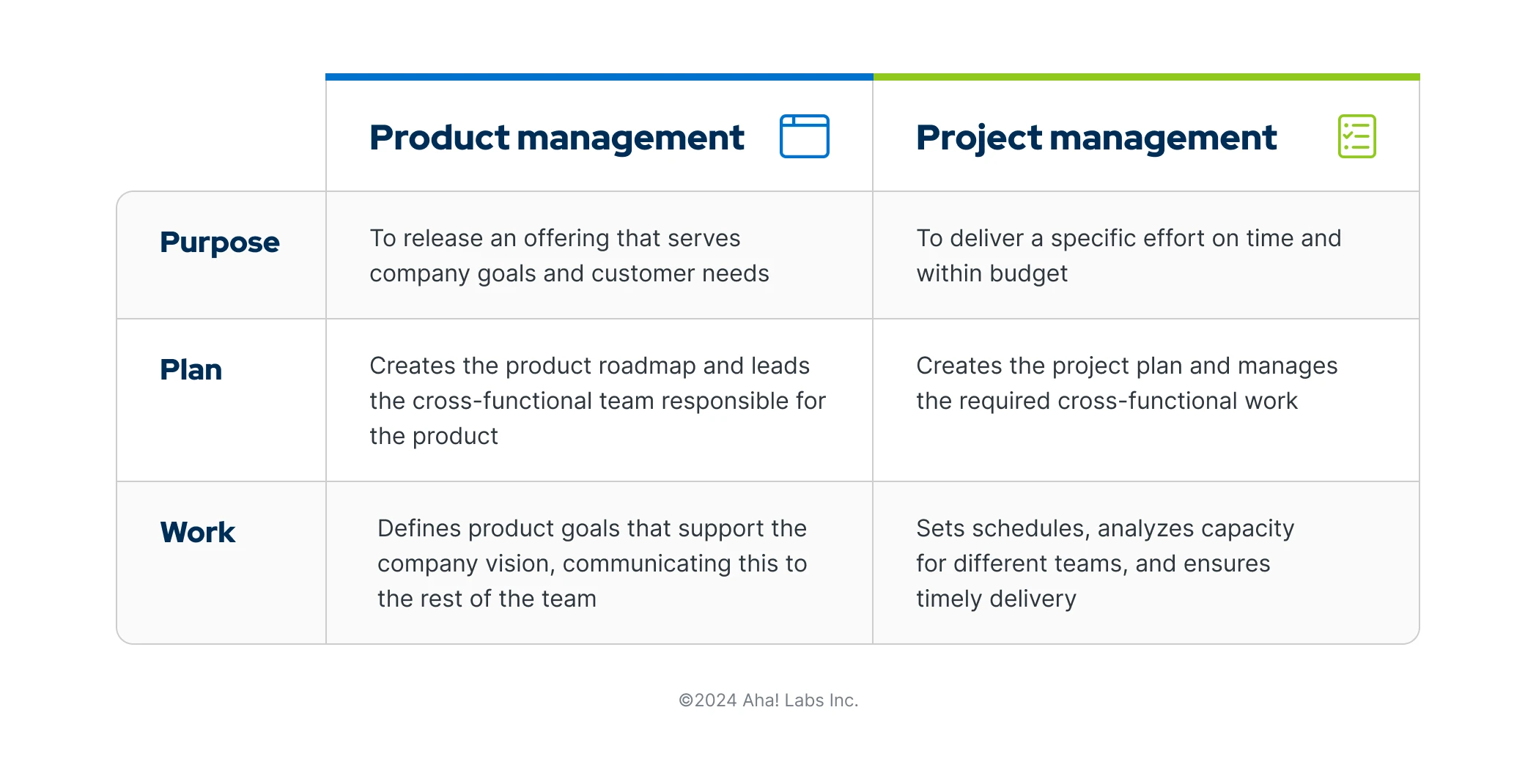
Related:
Product management responsibilities
Product management oversees product-related activities throughout every stage of the product lifecycle — from planning, development, and launch through to growth, maturity, and decline. This entails crafting the strategy, roadmap, and feature definition for a product or product line. Product management might also include auxiliary tasks like product marketing, financial forecasting, and managing profit and loss.
PM responsibilities include:
Setting a product vision and strategy that is differentiated and delivers unique value based on customer demands: This includes defining personas and analyzing market and competitive conditions. Using a business model template, like the one that is pictured below, can help you capture assumptions about your market, analyze the state of your business, and plan for new opportunities.
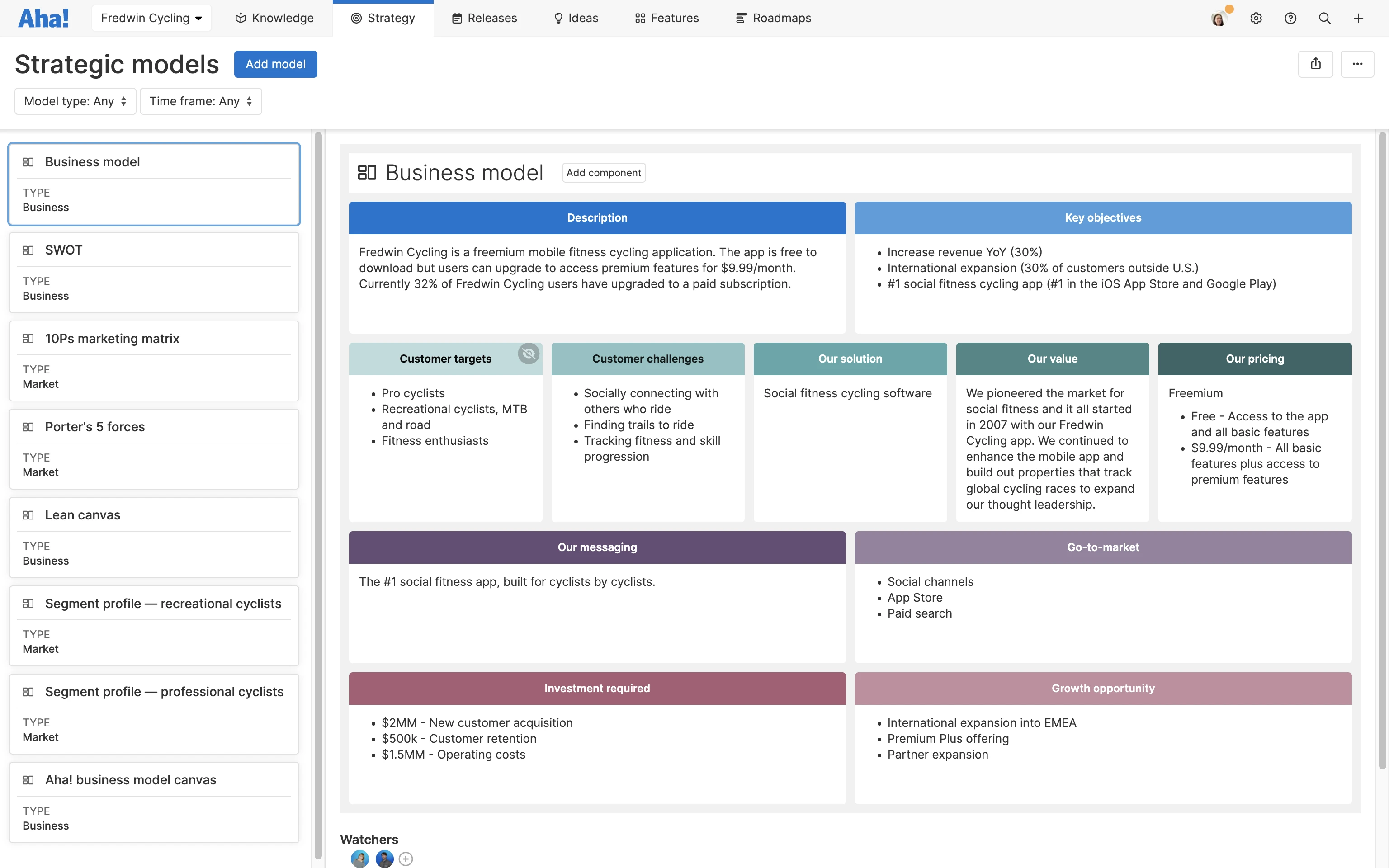
Defining what the product team will deliver and the timeline for implementation: This includes creating a release plan, capturing actionable feedback and ideas, and prioritizing features.
Providing cross-functional leadership — most notably across engineering, sales, marketing, and support: A key aspect of this is communicating progress against the product roadmap and keeping everyone informed about updates.
Leading the entire product launch process and all subsequent releases: Competitive research, product development, go-to-market strategy, and customer support readiness all roll up into a successful market entry.
Analyzing product success: This entails tracking product metrics such as customer usage and revenue to determine the success of your offering.
Another way to understand what product management involves is to consider internal (team-facing) vs. external (customer-facing) spheres of work. It is worth noting that product management and product marketing are typically separate roles, but there is frequent communication and close collaboration between them.
Internal product management | External product management | |
Focus | Internal product management involves gathering customer research, competitive intelligence, and industry trends — as well as setting strategy and managing the product roadmap. | External product management includes product marketing responsibilities such as messaging and branding, customer communications, product launches, advertising, PR, and events. |
Tactical examples |
|
|
Essential skills in product management
Achievement in product management demands a diverse set of skills. Product managers strive to be curious, thoughtful, compassionate, and organized. You work hard to align all stakeholders around a strategic vision and maintain a relentless focus on customer needs.
Day to day, this can look like working with UX designers to build wireframes on a digital whiteboard, collaborating with engineering to scope out new features, and meeting regularly with leadership to communicate progress on your roadmap. You need a wide variety of skills to do this successfully. Some of the most important ones include:
Strategic thinking: Product success relies on your ability to think beyond tactical work and deliver a Complete Product Experience to your customers.
Empathy: You need to know how to listen to customers, translating their pain points into real product solutions.
Leadership: The best product managers can keep the entire product team aligned and working toward a common goal.
Communication: Keeping the cross-functional team in sync is essential — this means understanding each team's needs and the most valuable information they will require from you.
Research skills: Understanding your customers and market is critical to product building. Compile research into user stories and competitive analysis to help teams make sense of it all.
Analytical skills: You need to measure progress every step of the way, especially as you iterate on your offering. Use analytical skills to dig into the data and discover the "why" behind the numbers.
Related:
LinkedIn Learning: Aha! Product Management Professional Certificate
Harvard Business Review: What It Takes to Become a Great Product Manager
Product management tools
Historically, product managers used a combination of spreadsheets, presentations, and text-based documents to communicate product strategy and even build a roadmap. This is still common today, but the static nature of these tools requires constant updates and introduces version-control chaos.
Over time, product managers began to experiment with developer tools and project management software. However, these fall short when it comes to communicating roadmap changes and prioritizing work based on strategy.
It became clear to Aha! founders Brian de Haaff and Chris Waters that there was a need for purpose-built product development tools — like roadmapping software. Product teams need a centralized place to set strategy, ideate on whiteboards, capture customer feedback, build beautiful roadmaps, document team knowledge, and more. Aha! software provides all of this functionality in one place, all while supporting teams that want to implement modern methodologies.
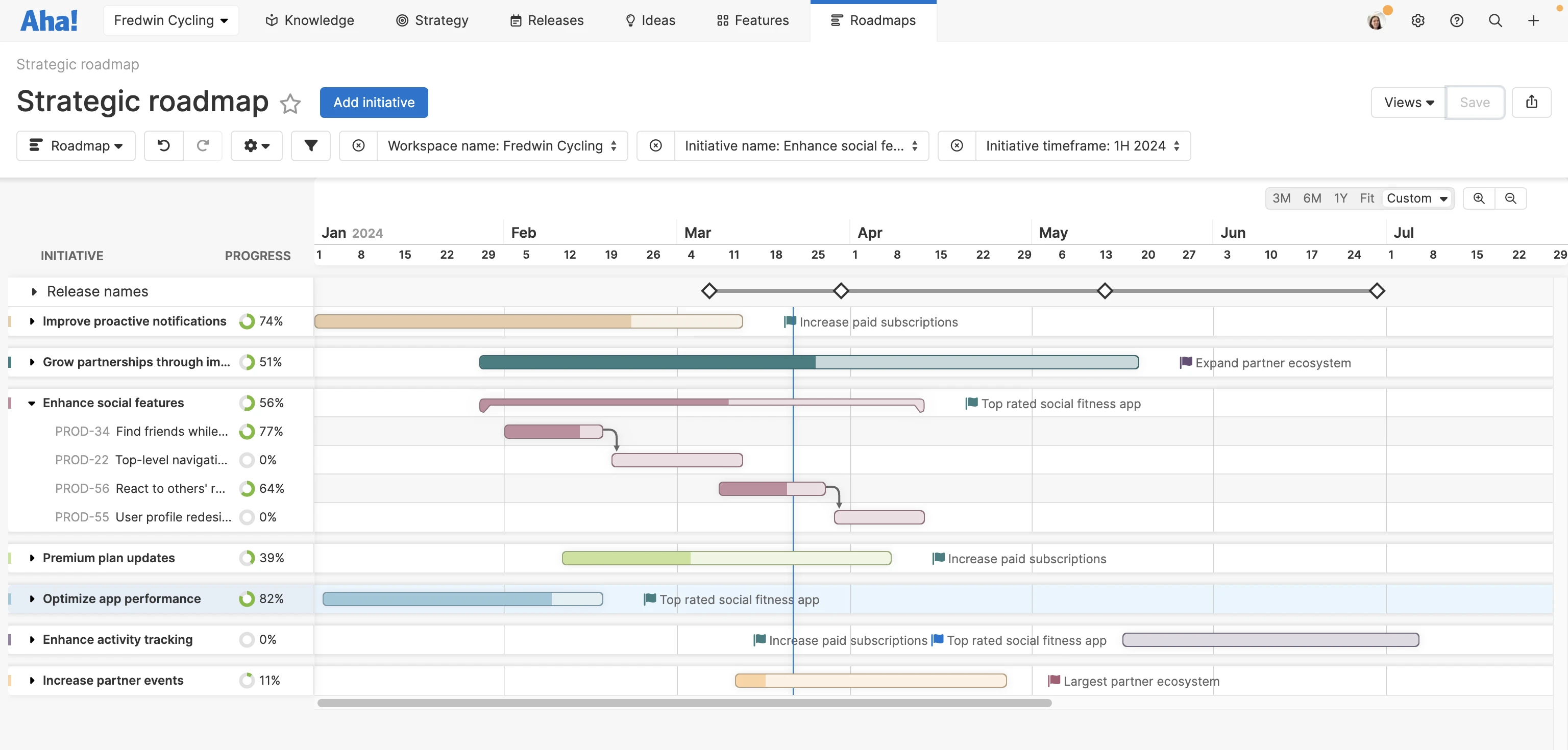
Complete work and collaborate on product plans — try Aha! Roadmaps free for 30 days.
Careers in product management
Product management is a well-paid and rewarding career. But the path into product management and the role you take on once you are there can look different for everyone.
Product managers often transition into the job from roles in engineering, marketing, sales, and customer service. For many years, product management did not have specific certifications, college degrees, or MBA paths, so you found your way in through adjacent careers. This is still common, but more formalized education paths do exist today.
PM careers can vary greatly across different companies and product types as well. Smaller to midsize companies might have one individual who takes on the roles of product and project manager, for example. On the other hand, larger enterprise organizations with vast product portfolios might have their own product management office that houses both entry-level and leadership positions. The graphic below can help you visualize what this might look like.
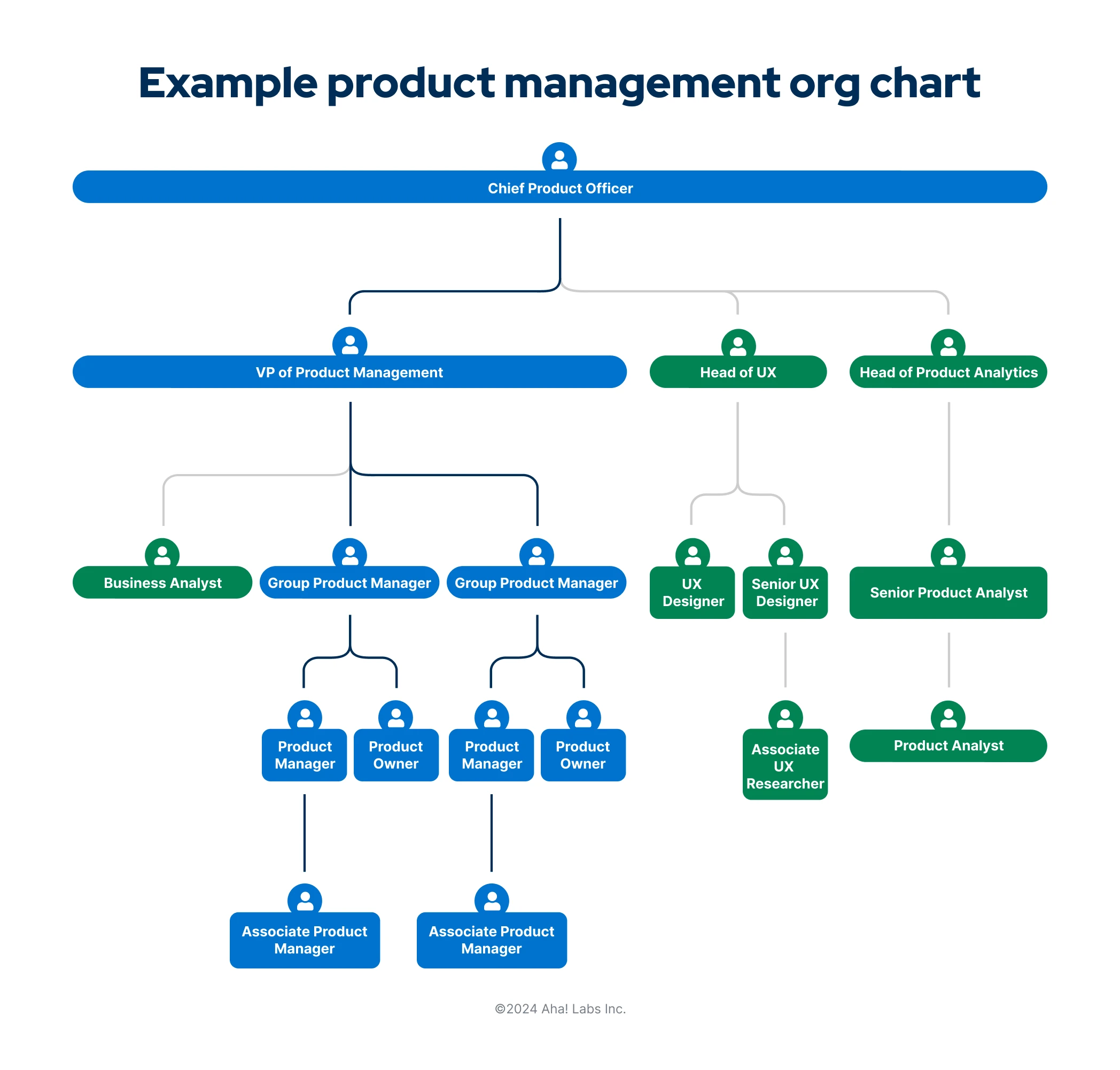
What is universal is that demand for qualified product managers is growing at every level. As markets get more complex and technology continues to evolve at breakneck pace, businesses have to keep up to stay relevant. That requires an intense focus on customers and the ability to shift from concept to launch continuously.
Product management roles: Finding your fit
Product management positions are as diverse as the products you help build, and each role has its own focus areas and responsibilities. Here are a few common examples:
Product manager: Manages the entire product lifecycle and roadmap
Growth product manager: Delivers business outcomes across growth, customer retention, and revenue
Technical product manager: Collaborates closely with engineering on core specifications and product functionality
Platform product manager: Oversees components shared across multiple products
User experience (UX) product manager: Ensures the user experience aligns with the product's vision
These different roles exist because companies have diverse priorities. For instance, a company might hire a growth product manager to drive expansion, or a UX product manager to focus on a mobile application.
As mentioned in the previous section, careers in product management often stem from positions in other departments. It is this experience that will help determine which type of product manager you become. An engineer transitioning into a technical PM role, for example, will draw from their hands-on development work to communicate effectively with the engineering team.
Some product managers might specialize in specific domains — such as healthcare, finance, or e-commerce. They might also focus not so much on a certain type, but rather a function (think: AI, e-commerce, or software as a service).
Related:
How to start a career in product management
Product management can come with a steep learning curve, especially if you are just getting started. And every company (and even teams within them) might see the role differently. This ambiguity makes it challenging for newcomers.
All this to say, most open product manager positions are not entry-level. Coursework and book study are great ways to develop foundational knowledge, but career success requires experience and skills acquired by actually being part of building and delivering products to customers.
If you are currently working on a different team and are interested in becoming a product manager, make your interest known and watch for opportunities. In your role now, do everything you can to learn about the product and your customers. Likewise, reach out to people in your network in similar positions who could serve as a mentor as you prepare for a new role.
Certifications for product managers
Today, there are myriad ways to continue your education in product management — training programs and educational materials are quickly being developed to support PMs who are looking to hone their craft.
For example, Aha! offers both fee-based and no-cost courses. With Aha! Academy, you can receive in-depth training from our skilled instructors and earn an Aha! Roadmaps certification. Free live tutorials are another good opportunity to learn best practices for using the Aha! suite from our team of product experts.
We have also partnered with LinkedIn Learning on a Product Management Professional Certificate. This online learning path will help you build foundational product management knowledge — from understanding the stages of product development and setting strategy to building a roadmap that serves your team and organization.
FAQs about product management
The aim of product management is to deliver value to customers and the business. Specifically, product managers achieve this by defining a bold product vision and strategy, deeply understanding customers and the market, and leading the broader product team to make progress against the product roadmap. Building and delivering a product that customers love is the ultimate reward for all the great work that you do as a product manager.
Product managers lead the cross-functional product team, which typically includes representatives from innovation, product management, project management, product marketing, engineering, and operations. And beyond this core team, product management works closely with members of marketing, sales, and support. Depending on the type of organization they work at, product managers might also interact with scrum masters, release managers, product operations managers, or technical PMs.
Inspired by agile software development methodologies, agile product management applies the principles of continuous improvement to the work of building and delivering products. Instead of planning products sequentially (and often slowly), agile product managers respond quickly to user feedback, collaborate closely with engineering, and release new customer experiences often. This agile approach allows for greater flexibility — you can continuously prioritize features and focus on delivering more value to customers.


